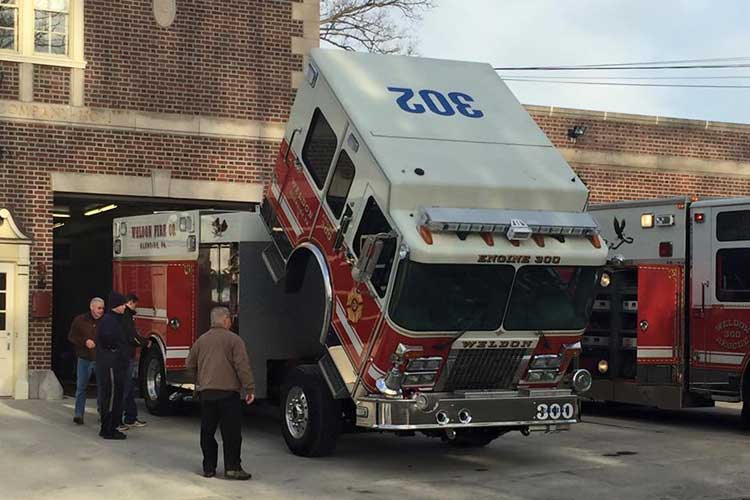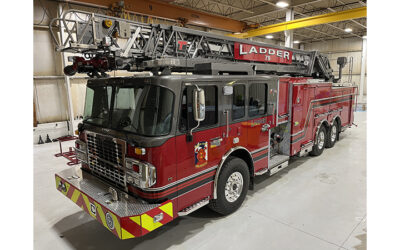Fire truck accidents are the “second leading cause of on-the-job deaths for firefighters.” This finding is the result of a National Highway Traffic Safety Administration (NHTSA) study, which noted that “about 70 percent of all fire truck accidents occurred while in emergency use.” One obvious way to bring this number down is to keep up with apparatus maintenance. What are the best ways to do that?
There are many resources and statistics available that address apparatus accidents and prevention. I will address observations and lessons learned from personal experience while working with my former department.
The first thing that comes to my mind is the condition of the tires—the foundation of the truck. Coming from an area that gets its share of rainfall throughout the year, good tire condition is imperative. Most standards use either 2/32” or 4/32” to gauge their tread depth on commercial vehicles. Our department adopted a policy of 4/32” and no less, for both front and rear tires.
We adopted a multiple-point policy—visual inspection of the tread depth every day and an actual measurement of each tire with a tire tread depth gauge for the monthly apparatus inspection report. Tire pressure readings also were recorded. We need to assure that we provide fields for measuring either six tires (pumper, ALS transport, etc.) or 10 (aerial apparatus and others) for entry of the measurements and pressures. The inner rear tires are the most overlooked because of their location and “inconvenient” access. No shortcuts or “pencil whipping” from the previous month’s record was allowed.
Obviously, brakes are an important component that cannot be overlooked. Performing a CDL brake test for air brake systems is the most thorough way of detecting any issues in the braking system. It is important to know what the gauges are telling you and what component is defective if there is a malfunction. This info can be better communicated to maintenance personnel so they can get a clearer picture of what repairs are needed. The test is too lengthy to discuss here in detail, but for the most part, the CDL tests the parking brake, emergency brakes, gauges, lights and warnings, and any leaks that may be occurring.
Vehicle hygiene must be maintained—in other words, assuring that all mirrors are cleaned with no water spots. The same goes for all the glass around the vehicle. This creates a “clear” view for all for routine movements and when responding to alarms. It also allows situational awareness of any activity occurring outside the vehicle. All emergency lights must be checked, and lenses cleaned to assure that they can clearly be seen when activated.
Assure that all lights are functioning. Check every bulb or LED light to confirm that it is illuminating. Interior lighting is just as important, especially when performing tasks at night. The apparatus is our rolling office. Besides driving and responding, we also need to access such items as: hydrant maps, DOT emergency response guideline reference, NIOSH references, binoculars, gate access cards and keys for residential areas, etc.
When a driver has been with the same vehicle day in and day out, he learns to know and feel the nuances of the vehicle handling characteristics. Any change or feeling, a new sound or “knock” can reveal that something is amiss and must be addressed. This usually comes from steering and/or suspension components. Any change or difference noted must be immediately addressed. There are many “hidden” areas on vehicles; therefore, it would be in the best interest for all to get the vehicle up on a lift and look for any faulty or broken components that may not be otherwise apparent when performing the daily inspection(s).
These routine inspections that occur daily, monthly, and even annually for some tests required by the NFPA can be addressed thoroughly by having a good documentation system in place. Having such a system also helps contribute to any accreditation recognition the department is seeking or already has, along with ISO ratings for department classification.
DRIVER BEHAVIOR
The other components of preventing accidents involve driver behavior. The two most important factors that can prevent fatalities are to “SLOW DOWN” and wear “SAFETY/SEAT BELTS.” A policy needs to be adapted that firefighters, when responding to a call, should not be “bunkering out” when the vehicle is in motion. “Dressing out” needs to occur before mounting the truck, and seat belts must be fastened before the vehicle departs.
Driver behavior itself can contribute to vehicle wear and tear due to bad habits. Granted, it is not about money, but it can save money in the long run. Every firefighter dreads changing out into another vehicle and would rather be in the new or newer “front-line” apparatus.
Depending on your run load, vehicle purchasing/replacement needs to occur at some time. Basically, determine the “service life.” Based on your resources and as a vehicle ages, more repairs start becoming apparent. Taking maintenance personnel away from performing preventive maintenance and having to deal with breakdowns of components to an aging fleet can cause delays and further malfunctions. Preventive maintenance is one of the most important factors to keep a vehicle from breaking down and performing correctly and “SAFELY.”
FRANK R. MYERS is a retired Lieutenant with the City of Miami (FL) Fire Rescue, where he served 32 years. Before his retirement, he served at the Training Center for six years as the Driver Engineer Instructor. Frank now serves as a Senior Advisor for PSTrax.com, a software platform that helps fire departments streamline and automate their apparatus, equipment, and narcotics programs.






